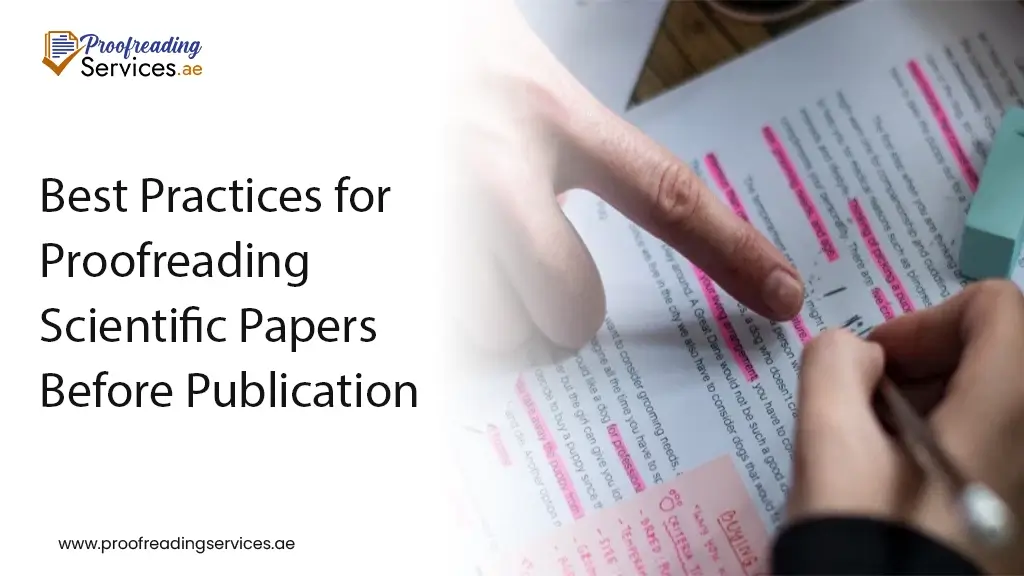Hey researchers! Are you about to publish your scientific paper? If yes, congratulations. That’s a big achievement!
A scientific paper reflects months or even years of research, experiments, and analysis. But some people make a common mistake of skipping proofreading.
No matter how good the quality of your content is. If there are errors in grammar, structure, references, or formatting, they can distract reviewers.
So in this blog, we’ll explore the best practices for proofreading scientific papers before publication, using simple language and actionable tips you can start applying today.
Why Proofreading Scientific Papers Is Important Before Submission?
Did you know? According to the 2016 study, 5,633 journals were indexed in the MEDLINE medical database. 90% of which were rejected mainly due to poor writing quality and inconsistent formatting. (Source: Word vice)
Consequently, the better you proofread your paper, the better it will be read and the higher your likelihood of being accepted. Proofreading is concerned with making sure that your paper is:
- Clear and easy to understand
- Devoid of grammatical and punctuation mistakes.
- Readable in tone, style, and formatting.
- In line with the requirements of the target journal.
- Finally, proper use of references and citations.
Important Note:
The writing in science should be accurate. Even the slightest error will cause the reader to get lost or affected by the results. Therefore, Proofreading Services Dubai ensures that what you write in your paper is understood.
Expert Suggested Tips to Proofread Scientific Papers
Scientific papers have some tips that a professional recommends to be used when proofreading an essay.
Some of the tips that are recommended to be used in proofreading scientific papers are as follows:
Take a Break Before Proofreading
Do not begin to proofread as soon as you are through writing. The brain is too accustomed to the text, and mistakes will be difficult to spot.
Therefore, relax for a few hours or days (according to the deadline) to resume work with new eyes. This distance will assist you in detecting errors with ease.
Look for Spelling and Grammatical Mistakes
You stand a possibility of committing some grammatical mistakes during manual proofreading. At this stage, we should resort to the help of grammatical checkers, e.g., Grammarly, ProWritingAid, or built-in spell checkers.
The thing is: however, you should not fully trust these tools. Automated tools are unable to detect problems related to context. As an example, scientific terms or abbreviations can be wrongly marked. Thus, it should never fail to do a manual check after using the software.
Focus on Concise and Clarity
Scientific papers are already hard per se. Use no long or complicated sentences. For example:
- Don’t: The experiment was carried out to identify possible changes in the activity of the enzyme due to changes in temperature.
- Do: The experiment tested how temperature changes affect enzyme activity.
The length of the sentences is short to enhance readability and maintain the argument.
Verify Scientific Accuracy and Terminology
Scientific papers have various abbreviations, terms, and units. And they must be used consistently and correctly.
For example, if you use “DNA” in one section, don’t switch to “Deoxyribonucleic Acid” elsewhere unless required.
Pro Tip:
Always remember that consistency in terminology strengthens the professionalism of your paper.
Check References and Citations
Incorrect or poor referencing is one of the most common reasons for rejection.
Therefore, always double-check:
- Every in-text citation matches an entry in the reference list
- The reference style matches the target journal (APA, MLA, Harvard, Vancouver, etc.)
- URLs, DOIs, and publication details are accurate and updated
Experts also recommend using online tools and software, such as EndNote, Zotero, or CiteThisForMe, to manage references properly.
Review Figures, Tables, and Captions
Another must-have in a scientific paper are figures, captions, and tables. In addition, they should be labeled correctly and referred to in the text. Make sure:
- Captions are clear and descriptive
- Units of measurement are correct and consistent
- Colors and symbols are easy to read
- No data is duplicated between figures and text
Follow Journal Guidelines Strictly
Every scientific journal has its own formatting and submission guidelines. In addition, these include word count, figure resolution, reference style, and even font size.
Hence, you need to carefully review the “Instructions for Authors” section on the journal’s website before proofreading. Keep in mind that ignoring these guidelines might result in immediate rejection.
Read Aloud for Coherence
Reading your paper aloud helps you catch awkward phrasing and long sentences. If a sentence sounds confusing when spoken, it will likely confuse readers too. To fix that, you can also ask a colleague or friend to read it aloud for a fresh perspective.
Pay Attention to Common Errors in Scientific Writing
People often make some common errors in a scientific paper, such as:
- Misuse of tenses (e.g., using the future tense instead of the past tense when describing completed experiments)
- Inconsistent formatting of headings and subheadings
- Overuse of passive voice
- Repetition of the same idea in different sections
If you’re aware of these mistakes, then your proofreading skills will become sharper and your work will stand out.
Proofread in Multiple Rounds
Don’t try to proofread in one go because it will make the work harder. Instead, you must proofread in layers:
- First round: Grammar and spelling
- Second round: Scientific accuracy and terminology
- Third round: References, figures, and tables.
- Final round: Journal formatting and flow
Final Words
Proofreading is not just a final touch it’s a vital step in scientific publishing. A paper full of grammar errors, formatting issues, or unclear sentences may distract reviewers from the real value of your research. By following these best practices for proofreading scientific papers, you can present your work in the best possible way and improve your chances of publication success.
